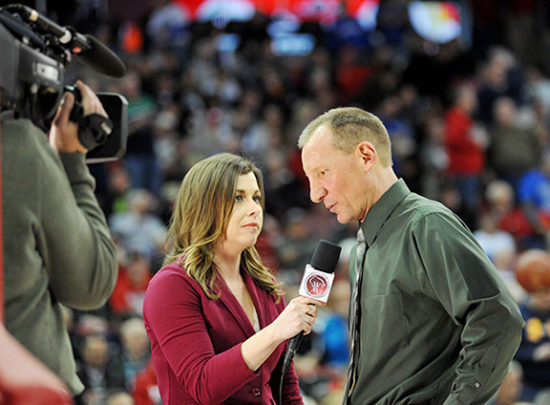Putting the media to work for athletes

Athletes spend most of their lives training for the chance to play professional sports. They buy the best equipment, hire the best trainers and spend a lot of money on nutrition.
But what they sometimes forget is what you do off the field is just as important as what you do on it. That’s why many high school and college athletes have engaged in media training to help promote their brand.“You can either promote your brand or watch someone tear it down,” says Don Yaeger, former Sports Illustrated editor and CEO of 180 Communications. ”But before you can focus on protecting your brand, you must know what it is and then market it shamelessly.
Yaeger and his team work with athletes all over the country, forcing them to look at themselves as the CEO of their own brand. With social media taking over the world, everyone is a reporter. When you play in a stadium with anywhere from 50 to 50,000 people, each person has the ability to take pictures, send messages or say something about you that could be seen by millions of people. Anyone with a smartphone can snap images, send tweets or update their Facebook pages before the next play is called.
“Now, more than ever before, you have to be aware of your surroundings if you are an athlete,” adds Yaeger. “Watch who you hang out with, where you go and what you do. If you dont, someone else will and before you know it, your actions have gone viral.
“Train your athletes on life skills, branding and social media pitfalls. Realistically, the majority of athletes playing in high school and college will never do an on-camera interview, but if they damage their reputation by saying something they shouldn’t, you can expect the media to show up.”
“The first step in marketing yourself is to identify who you are. Understanding brand words gave me time to sit down and really think about who am I? Who do I want the public to see me as?” says former Texas A&M linebacker, Garrick Williams.
Brand you
Media training isn’t just about sticking a camera in your face and asking you to speak. Media training is more about creating a brand.
Think of Starbucks as an example. Do you really need to spend $4 for a mocha? Probably not, but you do because you’re willing to spend more for a brand you trust. Is Volvo the safest car in the world? They say it is, and because of it, sales have exploded because people believe in the brand.
As a coach or an athlete, you need to think of yourself as a brand. What do you want people to say about you? Remember the adage where your mom said, “Don’t worry about what people think of you?” Now, you need to worry. People invest time, money and resources into people and brands in which they believe.
 “Peyton Manning is the perfect example of the value of a positive brand,” says Yaeger. “Before the Colts won the Super Bowl, Manning’s marketing team was trying to find out why no one wanted to hire him for endorsements. They did the SportsCenter spot where he and Eli were pushing each other in the hallway. It was an instant hit and now on any given Sunday, Peyton Manning is on your television promoting something.
“Peyton Manning is the perfect example of the value of a positive brand,” says Yaeger. “Before the Colts won the Super Bowl, Manning’s marketing team was trying to find out why no one wanted to hire him for endorsements. They did the SportsCenter spot where he and Eli were pushing each other in the hallway. It was an instant hit and now on any given Sunday, Peyton Manning is on your television promoting something.
“Manning’s marketing team branded their client as a guy who could have fun while playing football; a stark contrast to the guy who always looked unhappy and angry at his teammates. Manning’s value off the field is now an estimated $15 million per year. That’s on the high end of the brand discussion, but every athlete and coach from high school on up has the opportunity to be the CEO of their own brand if they market themselves as a product people must have.”
Pros & cons of social media
Nowadays, there is nothing that helps or hurts your brand more than social media. Every time you post a picture to Facebook or send a tweet, you should think about what kind of effect it has on you and your reputation. Many athletes learn the hard way and have to apologize for their mistakes while figuring out a way to correct them.
Social media is changing the way the media and others view public figures. Reporters don’t have to look for stories anymore — stories come to them. The information posted on blogs and social networking sites, such as Facebook or Twitter, is fair game for conversation and interviews.
“You hear it a lot of times coming from your school and you see players make mistakes,” says former University of Oklahoma linebacker, Travis Lewis. “It’s great seeing how you can improve your brand and yourself when it comes to the media.”
There are numerous examples of athletes who used the media to their advantage — others have learned a hard lesson. Josh Jarboe was one of the most highly touted recruits in the country in 2008. He signed a scholarship to play at Oklahoma. Shortly after he signed, he made a video with his friends talking about what he was going to do to the other teams in the Big 12. The video went viral, much to the dismay of the university who immediately pulled his scholarship.
Stories like this happen all the time, but they don’t have to if your players are trained on the pitfalls of social media and traditional media.
“It seems there is a story just like that one every day,” says Yaeger. “If student-athletes understand what they have to lose, they may think twice before hitting send on that tweet — or think before making a video that could haunt them for their entire career.”
High school athletes usually have an “it wont happen to me” mentality when it comes to getting in trouble in the media. But one bad tweet or inappropriate Facebook picture could mean the difference between a scholarship or not. Many college coaches say they check out every potential athletes Facebook and Twitter accounts before offering them a scholarship because they want to make sure the player they are signing will represent the university in a positive manner.
On a high school level, it’s up to the coaches to monitor the athletes. It’s hard enough keeping track of equipment, eligibility, playbooks and all other team-related issues. But if you don’t keep a close eye on what your players are doing, the media will — and that could backfire.
“Coaches work 15 to 18 hours per day,” says Yaeger. “That’s on the high school level. There are longer hours in college. You hope your athletes are doing the right thing. Having a life-skills and media trainer come in and show the student-athletes actions lead to consequences that can help you drive home your point and keep your athletes in the press for their successes.”
Every contact is a business opportunity
The value of media training isn’t measured with a stopwatch, but many athletes have success off the field because they know how to take control of an interview. The rule of thumb is to use each interview or tweet as a business opportunity to promote yourself or your brand. And you don’t have to be a professional athlete to follow these rules.
High school athletes need to market themselves to college coaches. And if you’re a coach, think of how marketable you become if you’re constantly using social media to congratulate other coaches or promote your teams successes. Set yourself apart from the rest by:
- Distinguishing your public and private answers.
- Determine the focus of the interview before the reporter starts asking questions.
- Understand your audience and the message you want to convey.
- Off-the-record does not exist.
- Understand the negative value of “no comment.”
Be concise when doing an on-camera interview: The average sound bite is 12 seconds or less.
“The media can be your best friend or they can be your adversary,” concludes Yaeger. “I have seen athletes like Michael Jordan and Peyton Manning who endeared themselves to the media because they focused on a central message and were good to the press. Others haven’t done it so well, and they are usually the ones who have negative headlines following them.”





